OFS Credit Company's May 2025 NAV Update: Navigating Uncertainty in a Volatile Market
The May 2025 NAV update for
Company (OCCI) reveals a fragile equilibrium between resilience and vulnerability. With its NAV estimated at $6.23–$6.33 per share, the closed-end fund's performance underscores the precarious balance of its CLO-focused portfolio amid escalating geopolitical tensions, macroeconomic uncertainty, and shifting U.S. policies. For investors weighing OCCI's prospects, the question is clear: Does this NAV range signal a buying opportunity, or a warning to stand aside?The CLO Conundrum: Performance Drivers and Risks
OFS Credit's portfolio remains heavily tilted toward CLO equity and debt investments, which accounted for 88% of its fair value as of April 2025. CLOs (Collateralized Loan Obligations) thrive in stable credit environments but falter during downturns, making them a double-edged sword. The May NAV's marginal recovery—up slightly from Q2's $6.17—hints at potential stabilization in CLO markets, but this optimism is tempered by three key risks:
- Interest Rate Volatility: The Federal Reserve's pause-and-see approach leaves markets guessing about future rate cuts. CLOs, which rely on refinancing corporate debt, face pressure if borrowing costs remain elevated.
Historically, this strategy yielded no returns, with a 0% average return and zero volatility, indicating no risk but also no reward. This suggests OCCI's short-term performance around Fed decisions has offered neither opportunity nor threat in this specific timeframe.
- Geopolitical Uncertainty: The Russia-Ukraine war and Middle East tensions disrupt global supply chains and energy markets, squeezing corporate balance sheets—a direct threat to the loans underpinning CLOs.
- U.S. Policy Shifts: Regulatory changes or trade disputes could destabilize structured credit markets, where OCCI's investments are concentrated.

Preliminary NAV: A Mirror of Near-Term Headwinds
OCCI's May NAV estimate is unaudited and subject to revision, a critical caveat for investors. The April 30 NAV of $6.17 already reflected a $0.71 per share decline from Q1 due to losses in CLO equity valuations. The May range suggests stabilization, but audited results in July could differ materially if market conditions worsen.
The stock price's volatility—swinging between $5.90 and $7.57 in May—highlights investor skepticism about the fund's ability to sustain its 20.7% annualized distribution yield. While the $0.115 monthly payout remains compelling, it hinges on stable NAVs. A further decline could force a cut, spooking investors.
Catalysts for a Turnaround: Rate Cuts and Geopolitical Calm
OCCI's prospects hinge on external catalysts:
- Interest Rate Cuts: A Fed pivot to easing would lower borrowing costs, easing pressure on corporate borrowers and boosting CLO valuations.
- Geopolitical Resolution: De-escalation in Ukraine or Middle East conflicts could stabilize energy prices and reduce credit defaults.
- CLO Equity Inflows: Strong demand for structured credit products could lift fair values, particularly if institutional investors return to the sector.
Buy, Hold, or Sell?
Buy: Aggressive investors with a high risk tolerance might see value in OCCI's 20%+ yield, provided they can stomach NAV volatility. The May estimate's stability offers a floor, and CLOs could rebound if macro risks ease.
Hold: For those already invested, patience is key. The unaudited July results will clarify whether the May uptick is real or a mirage. Avoid adding to positions until clarity emerges.
Sell: Risk-averse investors should exit if geopolitical or credit risks escalate. OCCI's leverage (35% debt-to-equity) amplifies losses in downturns, making it a poor fit for conservative portfolios.
Final Analysis: A High-Reward, High-Risk Gamble
OFS Credit's May NAV update paints a cautiously optimistic picture, but its CLO-heavy strategy leaves it exposed to macroeconomic whiplash. The $6.23–$6.33 range is a holding pattern, not a signal of strength. Investors must ask: Can I afford the volatility for a shot at outsized returns?
For now, wait for the July audited results before committing new capital. If geopolitical risks subside and rates trend lower, OCCI could outperform. But until then, this remains a high-stakes bet on structured credit's resilience.

Comments
No comments yet